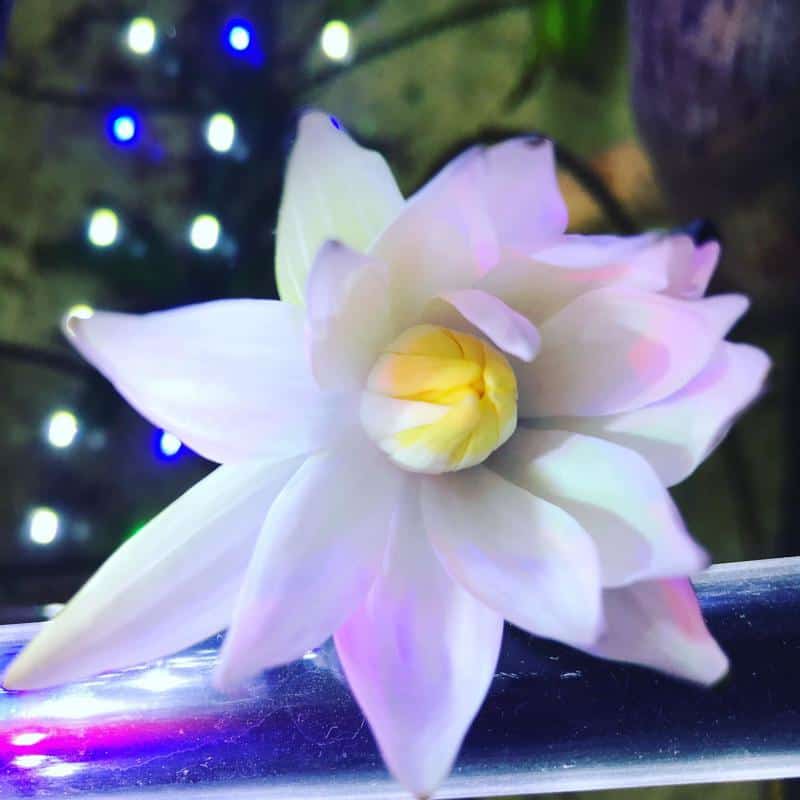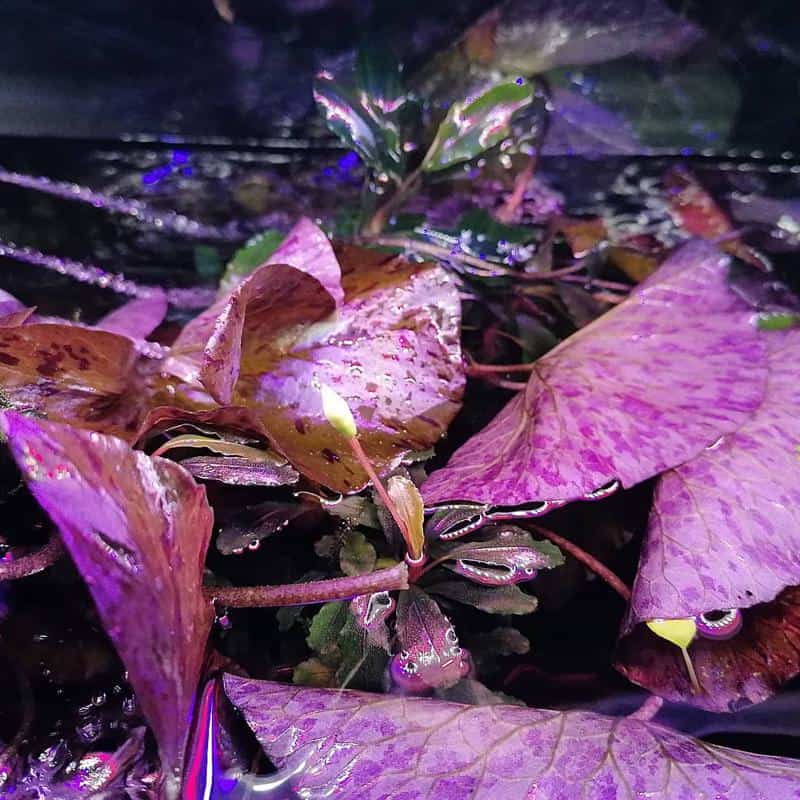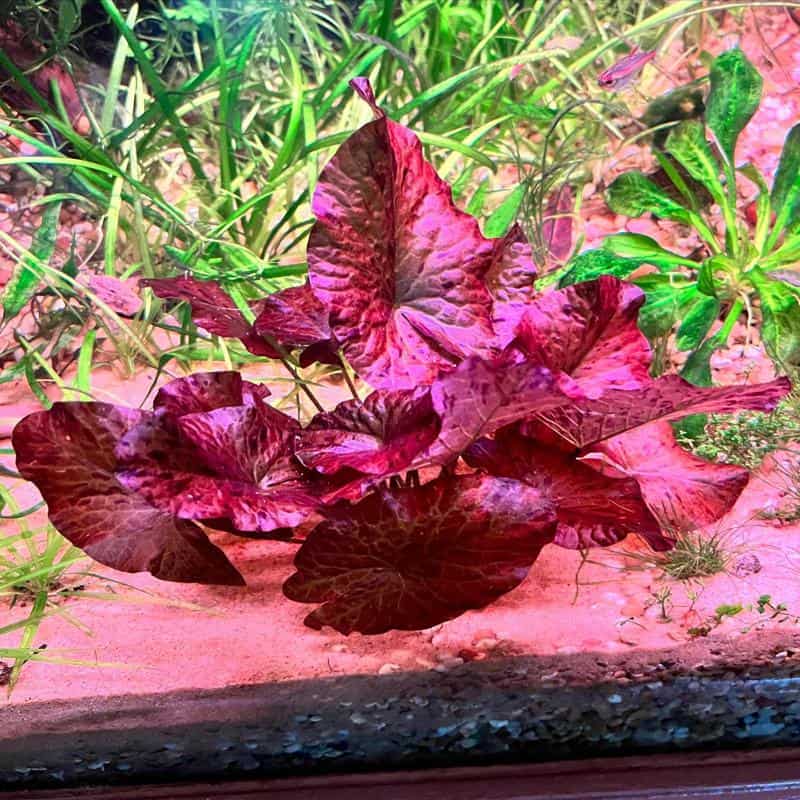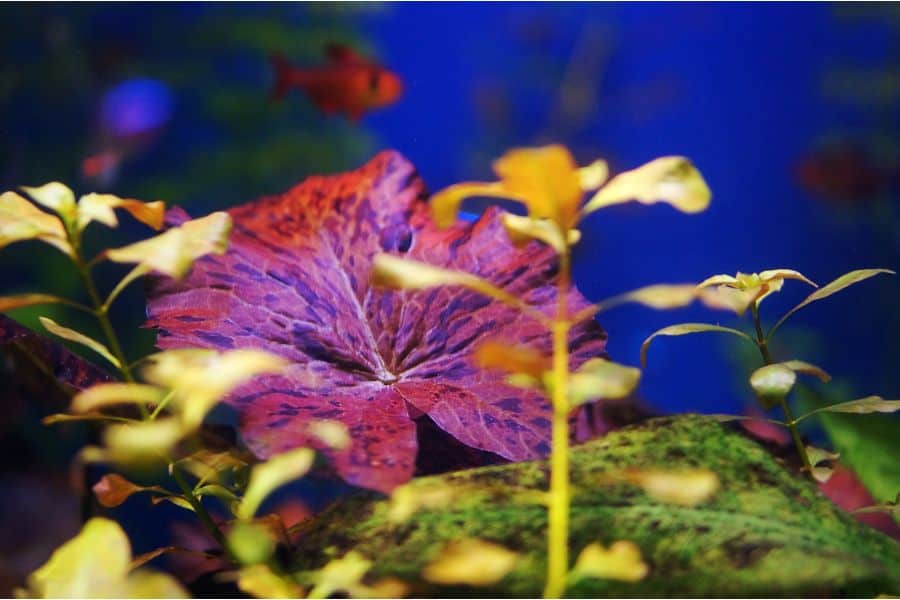When you go to a pet shop and look for aquarium plants, your color selection may be limited. The fact is, and in most cases, green-colored aquarium plants are your only choice.
When you set them up in the tank, you may be initially satisfied with how their greenery improves the aesthetic beauty of your tank. But over time, you will realize that having a single plant color can sometimes become bland and basic. Why not keep something not green, like the Red Tiger Lotus?
Join us in this article as we feature this centerpiece floral attraction and provide you with a comprehensive guide on how to keep and maintain the elegance of this red-leafed aquarium plant.
Red Tiger Lotus Biological Characteristics
Before keeping the Red Tiger Lotus in your tank, you must learn their biology for a better understanding of why such care and maintenance are required in growing this aquarium plant.
African Origins
The origins of the Red Tiger Lotus (Nymphaea zenkeri) can be traced back to its native land in Africa where they naturally thrive in the continent’s longest waterway – the Nile River.
Although the Nile River is a moderately flowing body of water, the Red Tiger Lotus thrives in narrow channels with less water flow, and in some cases, stagnant waters like in lakes and ponds.
Bulb Plants
When you take a closer look at the Red Tiger Lotus, you will see that they are unique from common aquarium plants. Aside from their obvious red coloration, their growth starts from a central circular mass called the bulb (just like the bulbs in onions).
Shooting out of the bottom part of the bulb are specialized roots that branch out underground. Once their roots have firmly anchored the bulb, stems and leaves will start to develop and shoot out on the top part.
Initially, the stems of a Red Tiger Lotus have a horizontal growth where their broad and heart-shaped leaves shoot out and may reach 6 inches in diameter.
Over time, once their horizontal stems clump together, they start producing vertical stems which is their way of maximizing their overall plant growth. This is the reason why a fully matured Red Tiger Lotus will have both submerged and surface leaves.
Fast-growing
The Red Tiger Lotus is a fast-growing plant and can grow a few inches daily. While you can easily notice the rapid development of this plant, its fast-growing trait is best represented in its floating leaves.
If left alone and provided with ample space and the right conditions, their surface leaves can reach an impressive size of 2 feet in diameter. Therefore, pruning (to be discussed later) is a routine for keeping the plant healthy and preventing them from dominating other aquarium plants.
Perennial: Flowering and Dormancy Period

Apart from being a fast grower, the Red Tiger Lotus is a perennial plant that has continuous growth. However, despite having steady growth, this plant has its ups and downs that you need to know for you not to be alarmed when it happens.
If you allow your Red Tiger Lotus to produce surface leaves, it may produce and bloom its lotus flowers (either white or pink). In their wild African environment, the flowering season of the Red Tiger Lotus occurs from June to October.
Following their flowering season is a period of dormancy. This is the only time the plant stops growing, and some of its leaves will shed off. Do not panic when you see this happen as it is part of their nature as a perennial plant.
Instead, what you should focus on is maintaining their ideal growth requirements. In this way, you shorten their dormancy period and the plant will resume growing in no time.
Also Read: Best Aquarium Plants with Flowers
Planting Procedure

When you go to a pet shop to buy Red Tiger Lotus, do not expect to purchase a fully grown plant with blooming leaves. In most cases, only the bulbs are for sale.
If you already have the bulb, don’t just plant them in the substrate as they have a planting style that is somehow different from other aquarium plants.
Half-buried
A common mistake aquarists (especially the newbies) do with Red Tiger Lotus is burying the bulb entirely in the substrate. If you do this, do not expect their roots to shoot out. In effect, the bulb will slowly rot and will not produce stems and leaves.
Instead, bury the bulb halfway to the substrate, exposing the other half in the water column. It takes 2 to 3 weeks for the roots to expand, anchor the bulb firmly to the substrate and for the stems and leaves to develop.
Spacing
If you plan to put several bulbs in a single tank, you should plant each bulb apart from the other to prevent overcrowding.
Aside from this, spacing is significant, especially in placing the bulb with other aquarium plants. You need to provide bulb space and away from the others.
Remember that Red Tiger Lotus are also allelopathic plants. As part of their defense mechanism, they release chemicals that restrict the growth of other species of aquarium plants. It is why the Red Tiger Lotus is often set as the centerpiece, while other species are on the side as background plants.
The good news is that the allelochemicals from the Red Tiger Lotus also control unwanted algae growth.
Growth Requirements
The elegant red coloration and fast-growing traits of the Red Tiger Lotus are associated with the right conditions, and depriving them of such essentials will not give the expected results.
These are the requirements for the optimal growth of Red Tiger Lotus.
Sandy and Nutrient-rich Substrate
Since the Red Tiger Lotus bulb requires only to be half buried, it does not require a specific type of substrate. Although you can use any substrate, we recommend sand with a 2 to 3 inches thickness. In this way, the roots can gently run along the soft texture of the sand while anchoring the bulb in place.
Another significant aspect of the Red Tiger Lotus that you need to know is they are root feeders. When its submerged roots develop, they spread out under the substrate and absorb nutrients directly in the sand.
When your substrate is nutrient deficient, the stems and leaves will not fully develop and bloom. It is why you need to enrich your substrate with fertilizers (to be discussed later in this section).
Moderate to Intense Lighting
The Red Tiger Lotus thrives in any lighting conditions. However, the plant will not fully grow in a low-light environment. They can have stunted growth, and their leaves will not attain their full red coloration. It can also be a trigger for the plant to become dormant.
To attain fast root development, shooting of stems, and blooming of their leaves, the Red Tiger Lotus needs moderate to intense lighting with 8 hours of daily light exposure.
You can use a full-spectrum LED light and place it at the central top portion of the tank. In this way, you are evenly distributing the light reaching the bottom-most leaves of the Red Tiger Lotus and other bottom dwelling aquarium plants.
Minimal Water Flow
The wild habitat of the Red Tiger Lotus has a stagnant to minimal water flow, and we recommend you mimic their natural conditions.
If you are using a powerhead filter, we suggest you switch to a low flow mode and elevate the nozzle (as well as the intake tube). In this way, the water current produced from water circulation will not reach or affect the substrate.
In case you disregard this growth requirement, you will personally see the consequence with both your eyes as the half-buried Red Tiger Lotus bulb tumbles over.
Tropical Water Condition
If there is a parameter that you need to focus on in keeping your Red Tiger Lotus, then it should be their water temperature. Aside from being tropical plants, they need a stable water temperature ranging from 22 to 28 C (72 to 82 F).
There will be no problems if you are in the tropics or the water temperature exceeds the range. However, if you live in the subtropics, the tendency is for your water temperature to decrease, especially during winter. In effect to lowered temperature, the Red Tiger Lotus goes dormant. Expect that their leaves will wither and eventually fall off from the plant.
Remember that the withering of their leaves is just a part of their dormancy, and they will produce new shoots once the temperature is back in its range.
To prevent sudden temperature fluctuation, we highly recommend you use a heater with auto-controls.
Fertilizer Supplements
Not to mention their sensitivity to temperature, the Red Tiger Lotus is not really a demanding plant. They can grow without supplements. However, applying fertilizer intensifies their red coloration and maintains its growth over time.
If you’re considering supplements, we recommend iron-rich fertilizers where this mineral is responsible for intensifying their red leaf color. And since they are root feeders, use the root tab version so that iron is directly fed to their roots.
If you want to create a bushy environment with the Red Tiger Lotus, you can use CO2. Here, you have 2 choices: the liquid drops or the gas injection kit. Nevertheless, both means of CO2 application amplifies plant growth where you can see vertical stems shooting up the surface in no time.
Just a caution with using fertilizers. You may not just improve the health of your Red Tiger Lotus, but you may also induce the growth of algae. So, administer only the right amount and according to the manufacturer’s specification.
Summary of the growth requirements for the Red Tiger Lotus
| Parameters | Range |
| Substrate | Sandy |
| Light | Moderate to High |
| Water flow | Stagnant to Low |
| Temperature | 22 – 28 C (72 to 82 F) |
| pH | 6 – 8 |
| Hardness | 2 – 15 |
| Fertilizers | Low to Medium |
| CO2 | Low to Medium |
Pruning Procedure

Pruning in Red Tiger Lotus is not just cutting excess growth to have a neat and tidy appearance. It also maintains balance to your parameters, and between other aquarium plants.
Never cut the roots or their modified stems called rhizomes, which sometimes are mistaken as roots. Only cut the true stems and their leaves.
Cutting Horizontal Growth
The Red Tiger Lotus are fast growers, and their horizontal growth can easily reach the walls of your tank.
Some aquarists are so lazy that they trim their Red Tiger Lotus too much that the bulb is exposed back again. Having this plant requires frequent trimming, and you should be ready to get your hands wet a couple of days per week.
Do not wait for the plant to reach other species of aquarium plants. Trim their stems and leaves accordingly, leaving behind a few inches of spaces between other plants.
In trimming their leaves, cut first those that are dying or dead. Be considerate in cutting them as they also need leaves for photosynthesis.
Cutting Vertical Growth
Not unless you want your Red Tiger Lotus to be completely submerged, then you need to cut all vertical stems.
However, consider leaving behind a single vertical stem. Not only will this produce surface leaves, it will give the aesthetics similar to their wild habitat. Also, if you are lucky, the surface flowers may produce the highly desired lotus flower.
Methods of Propagation
The Red Tiger Lotus is one of the many aquarium plants with high propagation success since it can be reproduced in several ways.
Disclaimer: We do not recommend this to newbies, and only those with enough experience should venture into propagating this red-colored plant.
Root Division
Do you believe that you can reproduce Red Tiger Lotus even if the plant is dormant? You can do this by uprooting the bulb, cutting clumped roots into smaller sections and planting them in new areas.
Rhizome Division
Differentiating roots between rhizomes can sometimes be hard. But in the case of the Red Tiger Lotus, you can easily differ them out. Their roots are completely submerged while their rhizomes are the root-like structure that crawls on top of the substrate.
Cut a piece of their rhizome and plant them in a new tank. Be sure that it has some section of the bulb. Otherwise, the rhizome will not grow and die off.
Seed Propagation
This method can only be done if you are able to produce lotus flowers. In case your plant produces flowers, you can collect the seeds before they wither and place them in a moist environment (wet tissue in my case) to germinate.
Read More: Dwarf Aquarium Lily (Nymphae Stellata) Care Guide
FAQs
How Can I Intensify the Color of Red Tiger Lotus?
In some cases, the leaves of the Red Tiger Lotus will not be as red as expected. Under normal conditions, the leaves may exhibit only red streaks.
If you want to intensify the red coloration in their leaves, apply iron-rich root tabs. Consequently, you can increase the intensity and length of light exposure.
How Do I Make Sure I Am Buying a Red Tiger Lotus Bulb?
It is difficult to identify a Red Tiger Lotus if it is only in its bulb form. Even if the bulb has juvenile stems and leaves, it is still hard to identify them as it may look similar to other species in the Nymphaea genus.
We suggest you only purchase a Red Tiger Lotus bulb from reputable sellers or known breeders.
What Should I Do if My Red Tiger Lotus Bulb Is Not Growing Stems and Leaves?
Given that three weeks have passed, you should expect stems and leaves to shoot out from the bulb. In case there is no growth, you can try uprooting the bulb, turn it over, and plant it halfway again to the substrate.
Allow another 2 to 3 weeks for the roots to develop. If no roots, stems or leaves sprung out on the second try, then you may have planted a dead or rotting bulb. Smell it, and the stench will tell you to throw it away and plant a new bulb.
What Is the Minimum Tank Size for Red Tiger Lotus?
With its fast-growing traits, the Red Tiger Lotus is ideal for large tanks. The least that you can use with this plant is a 20-gallon tank.
Final Words
The Red Tiger Lotus is truly a centerpiece amongst many aquarium plants. If you take care of them, they will grow splendid and often attract attention as they are not your ordinary green-colored plant.
What is remarkable with Red Tiger Lotus is that their appearance will depend solely on how you want them to appear. It’s really up to you whether you want them to be exclusively submerged or allow them to grow vertically and produce surface leaves and lotus flowers making your aquarium aesthetically beautiful inside and out.

